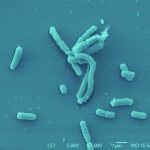Link to Pubmed [PMID] – 25566217
Front Microbiol 2014;5:701
Yersinia pestis, the plague bacillus, has an exceptional pathogenicity for humans. The plague bacillus emerged very recently (≈3,000 years ago) from the enteropathogen Y. pseudotuberculosis. Early after its emergence, Y. pestis became infected by a filamentous phage named YpfΦ. During the microevolution of the plague bacillus, the phage remained in the various lineages as an unstable extrachromosomal element. However, in the sub branch that caused the third plague pandemic, YpfΦ integrated itself into the bacterial chromosome to become a stable prophage. The genome of this phage has the same genetic organization as that of other filamentous phages such as the Vibrio cholerae CTXΦ phage, and shares high sequence identity with the CUS-1 filamentous phage of a high-virulence Escherichia coli K1 clone. In addition to genes involved in phage physiology, YpfΦ carries at each extremity of its genome two open reading frames with no predicted functions. This filamentous phage confers some selective properties to Y. pestis during the infectious process, which may explain why it was conserved duringY. pestis microevolution, despite its instability as an extrachromosomal element in most branches.

